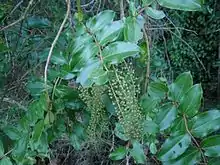Izatha mesoschista
Izatha mesoschista is a moth of the family Oecophoridae. It is endemic to New Zealand.
| Izatha mesoschista | |
|---|---|
.jpg.webp) | |
| Scientific classification | |
| Kingdom: | |
| Phylum: | |
| Class: | |
| Order: | |
| Family: | |
| Genus: | |
| Species: | I. mesoschista |
| Binomial name | |
| Izatha mesoschista Meyrick, 1931 | |
Taxonomy
This species was described by Edward Meyrick in 1931[1] using seven specimens collected by George Hudson in Wellington during the months of December and January.[2] Hudson discussed and illustrated the species in his 1928 work The butterflies and moths of New Zealand under the name Izatha balanophora[3] but later corrected his taxonomic error in 1939.[4]
Description
The larva of this species has not been described.[5]
The adult moth has a wingspan of 15.5–21 mm for males and 17–25 mm for females.[5] Adults are on wing from October to February.[5]
The appearance of the adult moths of this species is variable and as a result it was originally confused with Izatha balanophora.[5] However it can be distinguished from this species as I. mesoschista has a bold black line in the middle of the disk on its forewings.[2] This line also assists in distinguishing I. mesoschista from Izatha epiphanes.[5] Other than using their collection location as a guide, it is difficult to distinguish between I. mesoschista and Izatha haumu.[6] I. haumu is found at the top of the North Island and I. mesochista is present south of this locality, over the rest of the North Island.[7] However a male I. mesoschista can be distinguished from both I. haumu and I. epiphanes by the species characteristic three pronged tip of its genitalia.[5]
Distribution
I. mesoschista is endemic to New Zealand.[8][9] This species has been found throughout the North Island, except the Aupouri Peninsula, Hawkes Bay or the Wairarapa.[5] It is regarded as one of the most common and widespread species in the genus Izatha to be found in the North Island.[5]
Host plants

Specimens have been reared from Populus species, presumably from the dead wood, and also from pine logs.[5] Larvae of this species have also been extracted or reared from Coriaria arborea and Coprosma species.[7]
Trapping techniques
This species is readily attracted to light.[5]
References
| Wikimedia Commons has media related to Izatha mesoschista. |
| Wikispecies has information related to Izatha mesoschista. |
- Dugdale, J. S. (1988). "Lepidoptera - annotated catalogue, and keys to family-group taxa" (PDF). Fauna of New Zealand. 14: 1–123.
- Meyrick, Edward (1931). "New Species of New Zealand Lepidoptera". Transactions and Proceedings of the New Zealand Institute. 62: 92–97.
- Hudson, George Vernon (1928). The butterflies and moths of New Zealand. Wellington: Ferguson & Osborn Ltd. p. 279.
- Hudson, George Vernon (1939). A supplement to the butterflies and moths of New Zealand. Wellington: Ferguson & Osborn Ltd. p. 448.
- Hoare, R. J. B. (2 September 2010). "Izatha (Insecta: Lepidoptera: Gelechioidea: Oecophoridae)" (PDF). Fauna of New Zealand. 65: 1–201.
- Bennik, Rebecca M.; Buckley, Thomas R.; Hoare, Robert J. B.; Holwell, Gregory I. (2015-11-04). "Molecular phylogeny reveals the repeated evolution of complex male genital traits in the New Zealand moth genusIzatha(Lepidoptera: Xyloryctidae)". Systematic Entomology. 41 (2): 309–322. doi:10.1111/syen.12155. ISSN 0307-6970. S2CID 83666096.
- Bennik, Rebecca Marie (2014). Sexual conflict and genital evolution in moths (PDF) (Thesis). University of Auckland. Retrieved 28 April 2018.
- Gordon, Dennis P., ed. (2010). New Zealand inventory of biodiversity. Volume two. Kingdom animalia : chaetognatha, ecdysozoa, ichnofossils. Vol. 2. Christchurch, N.Z.: Canterbury University Press. p. 465. ISBN 9781877257933. OCLC 973607714.
- "Izatha mesoschista Meyrick, 1931". www.nzor.org.nz. Landcare Research New Zealand Ltd. Retrieved 2018-04-27.